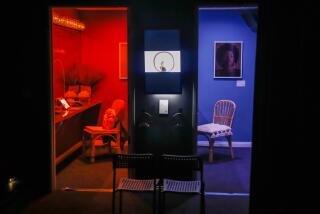Art Review : ‘Spirits’: How Baule Solve Marital Woes
- Share via
Half the world’s heartaches are probably caused by a universal conviction that, somewhere out there, our perfect lover exists. Life would be bliss if we could just find this imagined partner. Many folks just languish over this dilemma. The Baule people of Africa do something about it. All that is currently the subject of an enchanting small exhibition at UCLA’s Fowler Museum of Cultural History.
Titled “Spirits as People: Figurative Sculpture of the Baule Peoples, Cote d’Ivoire, West Africa,” the show is the brainchild of Philip Ravenhill, chief curator of the National Museum of African Art in Washington. The exhibition comes with a slender but indispensable catalogue.
It, along with about 40 carved wooden figures, explains how the Baule confront the timeless problem of connubial bliss. They believe that everybody has an essence or soul that lives in a splendid spirit realm before birth and returns after death. Each individual spirit has an ideal spirit lover of the opposite sex dwelling in the great beyond.
Meantime, in the pedestrian precincts of reality, people get married. Sometimes they believe their real partner is identical with their ideal partner, only to be disenchanted. Others, disillusioned beforehand, make a sensible choice, then become doubly disenchanted. In either case, when things go sour, a village diviner is called in to sort it out.
Diviners are special people on whom powers of clairvoyance are bestowed by the bush spirits. These are shadows that inhabit the wild world beyond the village and interfere with individual lives. They are as likely to bring the curse of madness as the gift of insight. Both diviners and bush spirits are represented. Carved in traditional fashion, they are nude, with large, elaborately coiffed heads, slender scar-tattooed torsos and thick sturdy legs.
When the diviner arrives to counsel a troubled couple, he or she often ascribes the problem to machinations of the spirit lover. The prescription for cure calls for a carver to fashion a figure of the invisible rival. This done, the recipient sleeps separately at least one night a week lavishing attention on the spirit effigy. Often both husband and wife posses these votive figures. In one case, a carving with the poetic name “Monday’s Dark Girl” was the sole companion of a widower for more than 50 years.
In contrast to the diviner and bush spirit figures, most imaginary lovers are depicted clothed in Western garb, an inheritance of the Ivory Coast’s days as a French colony. It makes them appear touchingly familiar to Western viewers. They are, not surprisingly, similar to fantasy-perfect lovers admired everywhere.
All of them displayed here appear young. Boys tend to run to social types. There’s a stiffly square youth in an immaculate suit, a dashing but gentle adventurer in khaki Bermuda shorts and bright yellow socks. The inevitable attraction to outlaws that Mom would hate seeps out in a couple of Elvis types with pompadours, black T-shirts and high-draped pants.
Girl figures are more enigmatic in character probably reflecting timeless masculine indecision between sweet-and-innocent and tough-and-sexy. There’s a bit of each in a zaftig , sloe-eyed girl wearing a virginal blue polka-dot frock. The bossy matron lurking behind one Miss-Manners-correct figure would drive most men to bachelorhood, but there’s no accounting for taste.
The Baule solution reflects great wisdom. It probably protects conventional social mores by heading off fantasies of homosexual or polygamous bent. Instead of agonizing about whether individual dreams of a fantasy lover are idiotic illusions or high ideals, it acknowledges their de facto existence. Given a respected place in the private realities of both partners, the figures preempt those awful rows that ensue when one partner catches the other thinking about someone else.
Freud didn’t believe in thought crime either. Neither did he hold that fetishism is weird or that there is anything wrong with a good, clean act of sublimation.
The exhibition finds the Baule taking a straight-ahead stand about the function of art. This work doesn’t dither on about formal solutions, semiotics or deconstruction. It says that beauty in art is that which most closely resembles beauty in nature. It says the purpose of art is to solve problems.
* UCLA Fowler Museum of Cultural History, through March 5, closed Monday and Tuesday, (310) 825-4361.
More to Read
The biggest entertainment stories
Get our big stories about Hollywood, film, television, music, arts, culture and more right in your inbox as soon as they publish.
You may occasionally receive promotional content from the Los Angeles Times.










